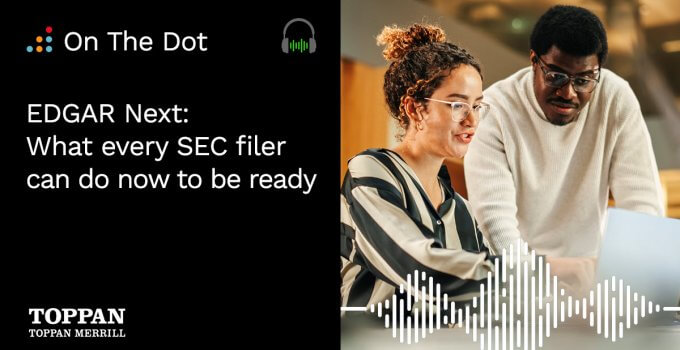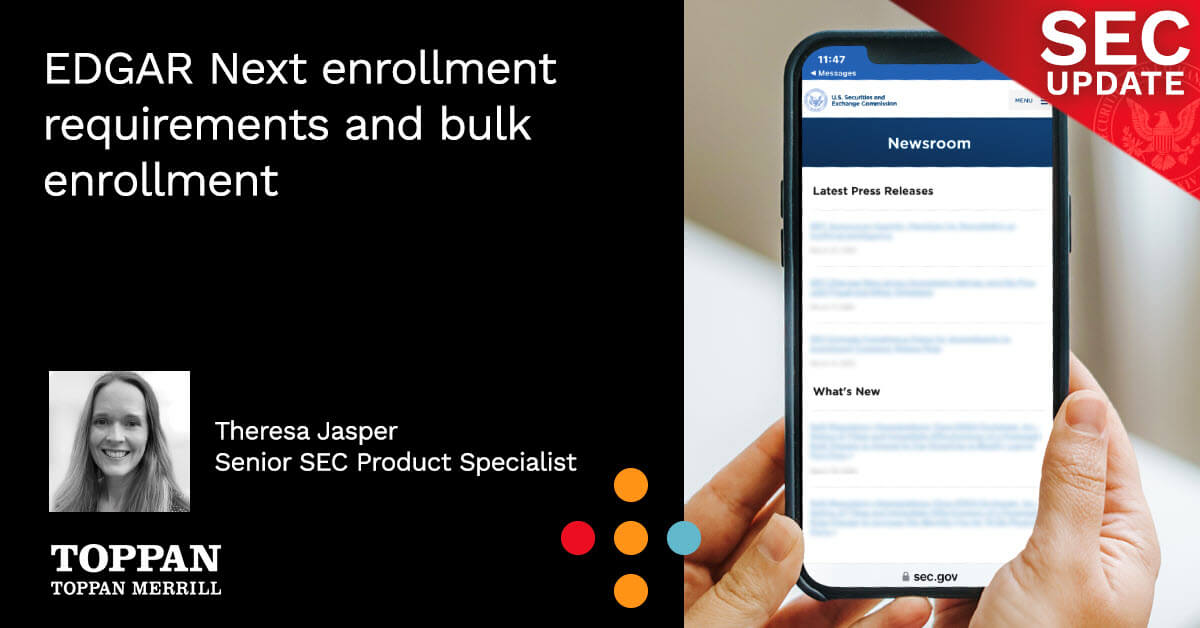Transcript
Scott Snyder: Hello, I’m Scott Snyder, and I’m pleased to be joined today by Gordon Ruckdeschel, Vice President of Compliance Services and Funds at Toppan Merrill.
Gordon, thanks very much for joining me today for this On The Dot episode and the second conversation in our EDGAR Next series.
Gordon Ruckdeschel: Thanks, Scott. Happy to be here.
Scott: Gordon, in the first EDGAR Next On The Dot episode, Jen Froberg shared a brief introduction of how EDGAR Next came to be and the intricate details and the requirements around what is still currently a proposed rule.
As the SEC reviews comment letters that came in and ultimately moves towards announcing a final rule, which Jen indicated probably in early 2024, questions from filers are obviously beginning to surface. You’ve been in the Beta environment, you’ve seen what filers will see, and ultimately what they’re going to need to do.
Can you give us a little insight into what maybe are the two or three things that you’re hearing today from filers as it relates to EDGAR Next.
Gordon: Sure. Thanks, Scott. I think first, actually, a lot of companies aren’t really dealing with this rule yet.
We are starting to hear from some, particularly those who manage a large number of what are called CIKs. Those are registrants on the EDGAR system.
So, there are companies out there, for example, large investment management mutual fund firms that manage 10, 20, 30, maybe 50 or more CIKs. So, for them this is more top of mind because they’re going to have a lot of work to do once this rule goes final.
Frankly, filers are pretty busy just starting to comply with all the other substantive rules that have come down from the SEC, including one of those rules is on cybersecurity, which touches very closely to EDGAR Next.
So, there’s been a cybersecurity rule that came out that companies are starting to comply with right about now. And that dovetails nicely with this rule, because frankly, EDGAR Next is all about cybersecurity and authentication.
So, we are starting to have some questions on what should we do to get ready. I think that we’ll hear more of that certainly as the rule goes final, because I’m sure there will be announcements from the SEC once the final rule is out there and coming up with a timeline.
Scott: So, Gordon, it feels like the rule is perhaps a little more administrative in nature. Is that perhaps why filers are not paying as much attention today?
Gordon: I think that’s right, Scott. I mean, it is more of a meta rule, right? It’s not related to the disclosure in the filings at all. And frankly, if we look at the history of the EDGAR system, we just celebrated the 30th anniversary of EDGAR. There’s over 20 million filings on the system. And for most of that time, many companies have relied on agents to sort of handle all of this for them.
Registrants would get EDGAR codes and then kind of turn them over. And that was it. They worried about getting their filing set up, but not how they interacted with the SEC on the backend. And all of that is about to change from an administrative point of view.
So, I think you’re right, and I think that when the rule goes final, we will see those some quick action.
Scott: So, let’s turn a little bit to the actual steps that filers are going to need to take. You’ve been in EDGAR Next. You’ve seen it. When those questions are coming in now, what are you sharing with clients about EDGAR Next? Maybe what are you telling them they should do even though the rule is still in proposed status?
What are you sharing with filers that maybe they could do today to be ready to avoid sort of that crunch time as the final rule comes into play.
Gordon: Sure. I think there are a few things that filers can do now to get ready. The most important one from our perspective is making sure that what’s called the EDGAR profile that they have is up to date.
So that is sort of a series of biographical information about each company that the SEC maintains. And importantly, that includes a contact at the company that the SEC can reach out to.
In our perspective, that is going to be the most important thing to keep up to date because once this rule does go final, each registrant, each filer is going to have to register onto the EDGAR Next system. And if that information isn’t accurate, that process may be more difficult. And as you said, with the crunch of filers all coming on board at the same time, that could seriously slow down the process.
Scott: Gordon, just actually logging in and looking at that biographical information you shared, it’s an important step.
Are there a couple of other things that you might advise companies to today?
Gordon: Yes. Thanks, Scott. There are a couple. There is a system called login.gov, which we discussed briefly in the last episode. That is a multi-factor authentication system that the SEC is planning to use to authenticate people onto the system.
So that’s similar to any website you would go to today where you go and log in, you get a code say sent to your phone and to verify and help make sure that it’s you.
The system that the SEC is proposing is that login.gov. So, at some point, you’ll have to have all of the users who you would expect would interact with the backend of the EDGAR system will need to have to have a login.gov account. Not necessarily that you have to sign up now but get familiar with that process.
Then the SEC has also put out a Beta site. So, if you go to the homepage of the Securities and Exchange Commission (sec.gov) you can get access to that Beta site and start getting familiar with what things likely will look like.
As we’ve said, there could be some changes based on the final rule, but this will give you some familiarity. Of course, because it’s not final, anything that you do in that system will not carry through to the final system.
Scott: Gordon, I want to reference something that Jen mentioned in the previous episode, which is just the sheer number of CIKs. She mentioned over 220,000 potential CIKs that are going to need to be updated in the EDGAR Next platform.
This obviously reaches further than just the filer themselves. Who else is going to get caught in this rule that’s going to have to really go in and make sure that everything is accurate in that EDGAR Next platform?
Gordon: Of those 220,000, a good number of those are actually individuals that are required to report on the EDGAR system as well. And that presents a whole other level of challenge with EDGAR Next.
Most public companies who file with the SEC also have to file on behalf of their officers and directors, and that’s where things get a bit sticky. Because as you can imagine, officers and directors of public companies are busy people and they don’t spend their day filling out a Form 3, Form 4 based on their security sales.
So generally, the filer, the issuer, would take care of that for them. However, all of those registrants, all of those individuals will need to get onto the system as well. So, there’s a logistical challenge there of making sure that they’re all set up so that they can continue to file. And those filings in addition have some of the tightest turnaround. So, within two days of a security sale, you’ve got to be on file.
Scott: So best advice, start early, be prepared, certainly the rule will become final early next year.
Gordon: Absolutely, and really go in and make sure that you have all the CIKs for the entities that you work with and make sure that their EDGAR profiles are up to date.
That’s our best advice at this point.
Scott: Gordon, thank you. This has been very informative. I really appreciate you joining me today. We certainly appreciate your insights, not only on the EDGAR Next rule itself, but really the impact on the issuers and, as you mentioned, down to the officers and the director level within the organization.
As the rule goes final early next year, we’ll certainly come back to you and to Jen to make sure that there are really no final changes that the SEC put in based on those comment letters.
Again, thanks for being here today.
Gordon: Thank you, Scott. Looking forward to it.



